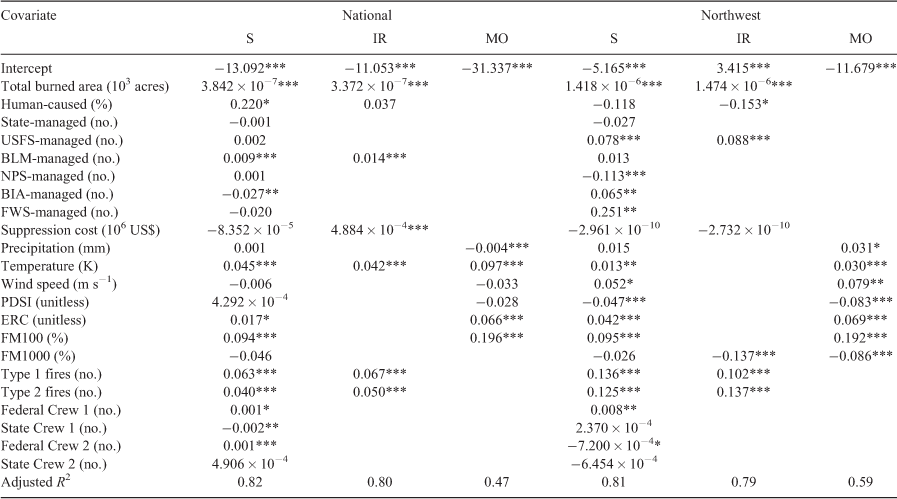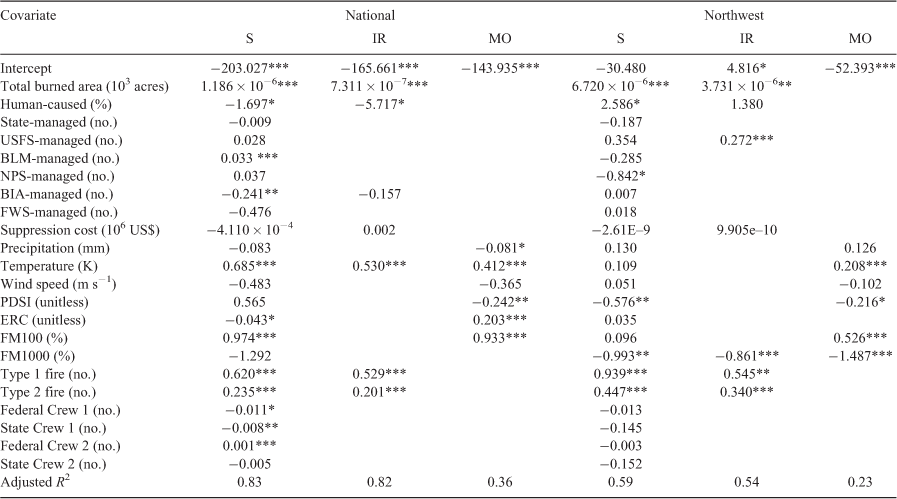High-severity wildfire potential – associating meteorology, climate, resource demand and wildfire activity with preparedness levels
Alison C. Cullen A C D , Travis Axe B and Harry Podschwit C
C
A Evans School of Public Policy and Governance, University of Washington, Seattle, WA 98195-3055, USA.
B Weyerhaeuser Company, Seattle, WA 98104, USA.
C College of the Environment, University of Washington, Seattle, WA 98195, USA.
D Corresponding author. Email: alison@uw.edu
International Journal of Wildland Fire 30(1) 30-41 https://doi.org/10.1071/WF20066
Submitted: 4 May 2020 Accepted: 17 September 2020 Published: 9 October 2020
Journal Compilation © IAWF 2021 Open Access CC BY-NC
Abstract
National and regional preparedness level (PL) designations support decisions about wildfire risk management. Such decisions occur across the fire season and influence pre-positioning of resources in areas of greatest fire potential, recall of personnel from off-duty status, requests for back-up resources from other areas, responses to requests to share resources with other regions during fire events, and decisions about fuel treatment and risk reduction, such as prescribed burning. In this paper, we assess the association between PLs assigned at national and regional (Northwest) scales and a set of predictors including meteorological and climate variables, wildfire activity and the mobilisation and allocation levels of fire suppression resources. To better understand the implicit weighting applied to these factors in setting PLs, we discern the qualitative and quantitative factors associated with PL designations by statistical analysis of the historical record of PLs across a range of conditions. Our analysis constitutes an important step towards efforts to forecast PLs and to support the future projection and anticipation of firefighting resource demand, thereby aiding wildfire risk management, planning and preparedness.
Keywords: climate change and projections, decision analysis, fire-fighting resource demand, fuel treatment, preparedness levels, prescribed burn, risk management.
Introduction
Firefighting resource demand and preparedness levels
Wildland firefighting operations in the United States manage wildfire risk through decisions made by multiple agencies. These decisions include pre-positioning firefighting resources to prioritise areas with the greatest fire potential, the recall of personnel from off-duty status, requests for back-up or contingency resources from outside the local area and responses to requests to share resources with other regions (see https://famit.nwcg.gov/applications/ROSS, accessed 7 April 2020; Gebert et al. 2007). Interagency cooperation is improved through daily forecasts of ‘preparedness levels’ (PLs), which are set at both national and regional scales. PLs help to signal a region’s ability to manage current and projected wildfire activity levels and inform decision-makers and stakeholders about the region’s firefighting resource availability and demand.
PLs are published daily in the United States by the National Interagency Firefighting Center (NIFC) to assess suppression readiness and firefighting resource demand in a given area (https://www.nifc.gov/fireInfo/nfn.htm, accessed 7 April 2020; Schlobohm and Brain 2002). PL is a discrete index that takes values between 1 and 5, where higher values reflect higher resource demand. National PLs are set by the National Multi-Agency Coordinating Group (NMAC) to ‘help assure that firefighting resources are ready to respond to new incidents’ (see https://gacc.nifc.gov/nwcc/, accessed 7 April 2020). Regional PLs are set according to the same structure but are determined and managed independently by 11 Geographic Area Coordination Centers (GACCs), which together encompass the entire United States (Fig. 1). As a result, the criterion defining the five PL categories between two GACCs – for example in the Northwest (https://gacc.nifc.gov/nwcc/content/pdfs/2020%20Update_NW_PreparednessPlan.pdf; accessed 2 September 2020) and Rocky Mountains (https://gacc.nifc.gov/rmcc/publications.php) – can differ.
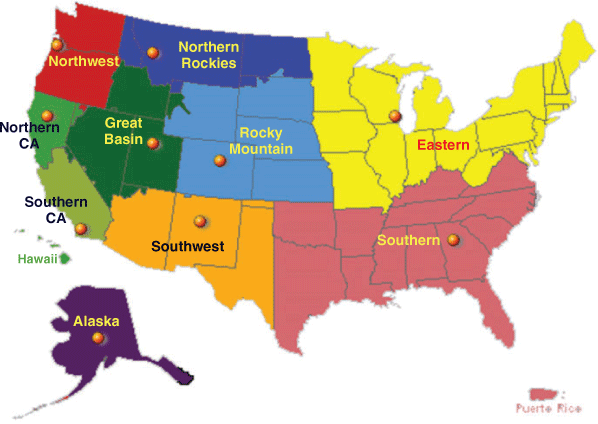
|
Factors associated with preparedness levels
The NIFC states that PLs are broad categories defined according to a combination of factors including weather conditions, expected fire activity and resource availability (see Table 1). Although PL category descriptions are explicitly defined by the NIFC, PL setting remains both a quantitative and qualitative consultative process among responsible personnel because of the numerous factors that must be weighed, and their nuanced interactions. As a result, the exact decision process used to assign PLs is not strictly deterministic. For example, if faced with exceptionally unfavourable fire weather but little fire activity, the decision about what PL to assign must incorporate both quantitative factors and local and regional experience and other information. The weight given to each factor relies on the judgement of the personnel setting the PL. Therefore, discerning a comprehensive algorithm for setting PLs is understandably an elusive goal.

|
From the historic record of observations, we can identify which aspects of fire activity, weather conditions and resource availability exhibit statistical associations with PL. This analysis improves our understanding of the decision processes that generate PL assignments. With a better understanding of how these individual factors are associated with PL levels, future PLs can be more accurately forecast. Having accurate PL forecasts can aid decision-making about wildfire-fighting resource allocation by helping anticipate when and where resource demand and wildfire risk will be elevated. Forecasting PL provides a more nuanced measure of resource demand than is provided by any single element incorporated in a PL. For instance, forecasting the number of fires in a region does not tell as complete a story about expected resource demand as being able to gauge what PL category will be assigned, as the latter accounts for the number of expected fires while also considering multiple additional factors relating to resource availability and local constraints.
Many of the factors considered in PL setting are well established as important determinants of the effectiveness of fire suppression decisions and efforts. Several studies have determined that the presence of multiple co-occurring fires strains firefighting resources in special ways (Bednar et al. 1990; Tedim et al. 2018; Podschwit and Cullen 2020). Weather has also been shown to play a complex role in mediating wildfire activity (Flannigan et al. 2009; Littell et al. 2016) and, by extension, firefighter demand. Lastly, the number of firefighter crews available for deployment has important implications for preparedness.
Predicting preparedness levels
PLs and related resource demand can be predicted in the short term (days or weeks) from standard meteorological forecast information. Longer seasonal forecasts incorporate meteorological and other information and can inform decisions about positioning, requesting and sharing resources. Even longer-term PL and resource demand forecasts, looking years or decades ahead, are reasonably projected using future climate conditions and inform decisions about forest management, fuel treatment or land use (Littell et al. 2011; Fischer et al. 2017). Overall, to accurately forecast PL, we need to better understand how models based on characteristics of fire activity, weather conditions and resource availability can help accurately predict the assigned PL value for a given day and context.
Beyond discerning the characteristics associated with PL and understanding their interactions, there are several additional challenges to accurately forecasting PL assignments. First off, the information base that supports prediction of any factor varies in quality and quantity depending on time scale. Projections of fire weather conditions and firefighter availability in the near term are more reliable than projections running decades into the future owing to uncertainty in climate model projections and assumptions we make about future land use, fuel management, fire suppression and prescribed burning. Additionally, data sources that inform perceptions about fire weather, fire activity and resource availability are variable. For example, wildfire activity is driven by complex meteorological factors (Meyn et al. 2007; Flannigan et al. 2009; Littell et al. 2016) that vary by region (Podschwit et al. 2018) and over time (Krueger et al. 2015). Even when the meteorological context is well understood, relevant information bases may be inconsistently available or of variable or unknown quality. For example, although drought is commonly associated with increased fire activity, there are multiple defensible choices of drought index (Svoboda and Fuchs 2016). In summary, we hypothesise the existence of nuanced interactive relationships among a rich array of factors that influence PL setting. We also posit that these qualitative and quantitative factors, and the implicit weighting applied to each, can be discerned by analysing the historic record of PLs across a range of contexts and conditions.
Research questions
To gain insight into the factors and complex interactions that coincide in high wildfire potential, we generate and investigate statistical models that predict national and Northwest daily PLs. Specifically, this analysis addresses three underlying questions:
What factors are most important for predicting PLs as assessed over the historic record?
How much of the variability in PL assignment is explained by these factors?
How does the availability of non-meteorological covariates impact PL predictions as assessed in the historic record?
Methods
Data
PL data for our analysis come from the NIFC (see https://www.nifc.gov/nicc/administrative/nmac/index.html, accessed 7 April 2020). This analysis considers PL in two formats: (1) raw PL values on a scale of 1 to 5, and (2) high-resource-demand events. Raw PL values are an ordinal proxy for resource demand, where increasing values are associated with increasing resource demand. PLs are reported at near-daily intervals during peak fire season, with more occasional updating during the shoulder seasons. Firefighting resource demand is modelled in a secondary analysis as a binary variable, where PLs 4 and 5 are coded as ‘high-resource demand’ (HRD) events (or days) with increased competition for resources and elevated fire activity, while PLs 1, 2 and 3 are coded as ‘low resource demand’ (LRD) events (or days).
The historic record reveals that HRD occurs infrequently. From 2007 to 2013, only 8% of days were designated high severity nationally, and only 4% were designated high severity in the Northwest GACC, none of which were PL 5 (see Fig. 2). Because of the relative abundance of LRD days in the historic dataset, and a corresponding lack of fire-suppression data for months outside the fire season, we restrict our analysis to the period from May to October for 2007 to 2013.
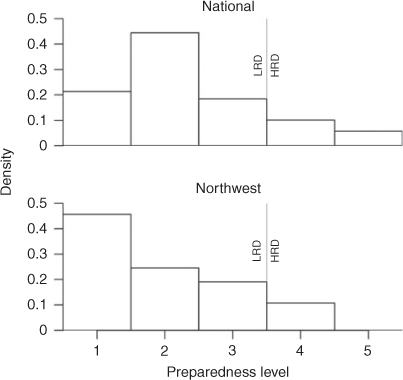
|
The primary unit of analysis is an individual day, midnight to midnight, for which all fire activity, fire characteristics, resource allocations and climate and weather data intersect. Our sample size differs between the national analysis (n = 1217) and the Northwest analysis (n = 1012) because of differing censor rates between the two time series.
Firefighting demand covariates
Historic Interagency Situation (SIT-209) reports form an exhaustive dataset detailing the number and type of suppression resources that are allocated to each wildfire in the USA from ignition to suppression. Annual SIT-209 reports are publicly available through the National Fire and Aviation Management Web Applications (https://fam.nwcg.gov/fam-web/, accessed 3 April 2020). SIT-209 reports are submitted daily for every fire incident from the time it is designated as a wildfire, i.e. an unplanned ignition or escaped prescribed fire that involves at least 1000 acres (404 hectares) cumulatively before being suppressed. Each fire is associated with a distinct reporting unit, which is managed by a single, larger dispatch unit, which is in turn managed under a single GACC. This relationship chain allows the analysis of fire information through a hierarchy of management. Our study uses daily SIT-209 information about the number of federal and state-level Type 1 and 2 crews involved in actively burning fires. A list of the firefighting covariates considered in our analysis appears in Table 2.
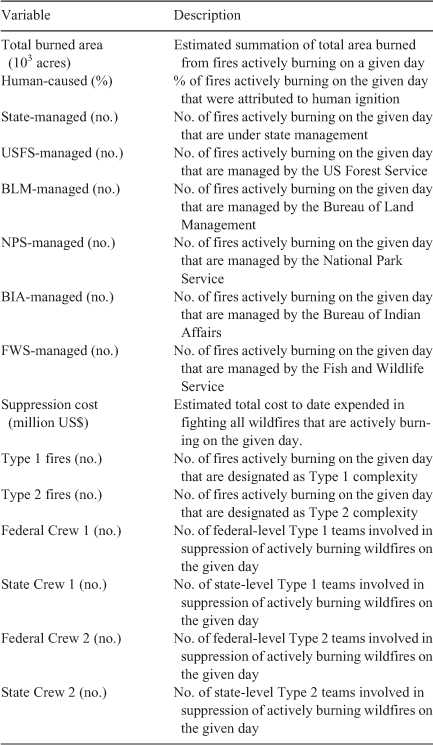
|
Meteorological covariates
Daily spatial average values for climate variables were obtained through the gridMet platform (http://www.climatologylab.org/gridmet.html, accessed 3 April 2020) developed at the University of Idaho. gridMet contains daily high-spatial-resolution (~4-km, 1/24th degree) surface meteorological data covering the contiguous US from 1979 to the present. gridMet data undergo validation against an extensive network of weather stations including Remote Automatic Weather Stations (RAWS), AgriMet, AgWeatherNet and the United States Historical Climatology Network (USHCN-2) (Abatzoglou 2013). For our analysis, climate data are averaged over both the continental US and the Northwest GACC. A list of the meteorological covariates appears in Table 3.
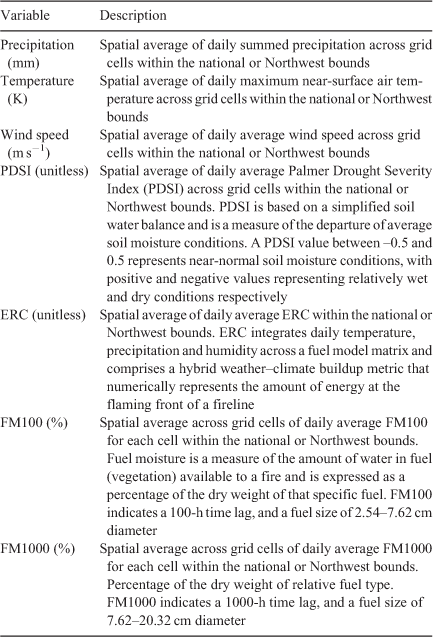
|
Model selection
We develop statistical models predicting PL that reflect spatial variability (i.e. national and Northwest) and response (i.e. raw preparedness level for high- and low-resource-demand days). Both raw PL and HRD days are modelled using generalised linear model frameworks. Raw PLs are predicted using an identity link with normal response. HRDs are modelled using a logit link with binomial response.
To reflect data availability differences that we expect would be faced by users with interests in short-, medium- and long-term PL predictions, we produce three model versions for each spatial scale and response. We label these three models ‘saturated’, ‘information-rich’ and ‘meteo-only’. The saturated model predicts resource demand incorporating all of the covariates presented in Table 4. The information-rich model predicts resource demand using the subset of covariates relevant to firefighting and meteorology. The meteo-only model uses only meteorological information to predict resource demand. Each model version is produced with a different selection procedure. The saturated model includes all meteorological and firefighting predictors; thus, there is only one candidate model. The initial set of model candidates for the information-rich model is more complex because these models must include covariates representing all six dimensions hypothesised to correlate with resource demand (see Table 4). In most cases, each of these six dimensions is represented with a single covariate. However, in the firefighting resource group, two covariates are included in order to represent both Type 1 and Type 2 crews, i.e. those committed to highly complex and typical wildfire incidents respectively. Hence, the initial model set for the information-rich models contains 126 candidates, each with 11 covariates. The initial model set for the meteo-only model consists of all linear combinations of meteorological covariates (i.e. 128 candidates). Finally, in each case (saturated, information-rich and meteo-only), the model in the candidate set with the best explanatory power (i.e. highest adjusted R2) is selected to represent the group (Zhang 2016). The effects of multicollinearity on standard errors are quantified using variance inflation factors (Supplementary material Fig. S3). Normality assumptions are tested using Kolmogorov–Smirnov tests, and model residuals are plotted for inspection (Supplementary material Figs S4–S15).
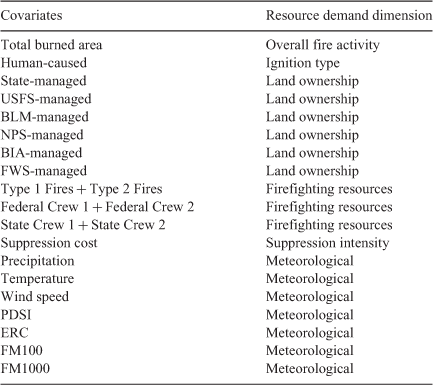
|
Model validation
The skill of each selected model is assessed using root-mean-square error (RMSE) to gauge performance and is estimated using stratified cross-validation (Diamantidis et al. 2000). For the cross-validation, 4 years of data are designated as the testing dataset and the remaining data are used to fit each selected model. The difference in RMSE between the model fitted using the training data and the result based on the testing dataset is then calculated. This process is repeated for all  combinations (i.e. 35 folds) of years and averaged across the simulation.
combinations (i.e. 35 folds) of years and averaged across the simulation.
Results
Summary of models
Preparedness level – linear models
The saturated models exhibit performance above that of information-rich or meteo-only models for predicting raw PL, with an adjusted R2 of 0.82 for the national model and 0.81 for the Northwest. In the national model, 12 predictors are statistically significantly associated with PL (α = 0.05): Total burned area, Human-caused, Bureau of Indian Affairs (BIA)-managed, Bureau of Land Management (BLM)-managed, temperature, ERC, FM100, Type 1 fires, Type 2 fires, Federal Crew 1, Federal Crew 2 and State Crew 1. In the Northwest model, 14 predictors are statistically significantly associated with PL: Total burned area, US Forest Service (FS)-managed, National Park Service (NPS)-managed, BIA-managed, Fish and Wildlife Service (FWS)-managed, temperature, wind speed, Palmer Drought Severity Index (PDSI), ERC, FM100, Type 1 fires, Type 2 fires, Federal Crew 1 and Federal Crew 2 (Table 5).
The information-rich models are also highly explanatory, with adjusted R2 of 0.8 and 0.79 for the national and Northwest models respectively. At the national scale, six predictors are statistically significantly associated with PL: Total burned area, BLM-managed, Suppression cost, Temperature, Type 1 fires and Type 2 fires. For the Northwest model, six predictors are statistically significantly associated with PL: Total burned area, Human-caused, USFS-managed, FM1000, Type 1 fires and Type 2 fires (Table 5).
The meteo-only national and Northwest models have adjusted R2 of 0.47 and 0.59 respectively. In the national model, four predictors are statistically significantly associated with PL: Precipitation, Temperature, ERC and FM100. In the Northwest model, seven predictors (every available meteorological covariate) are statistically significantly associated with PL: Precipitation, Temperature, Wind speed, PDSI, ERC, FM100 and FM1000 (Table 5).
High resource demand – logit models
Among logits predicting HRD days, the saturated models have the most explanatory power, with adjusted R2 of 0.83 for the national case and 0.59 for the Northwest case. At the national scale, 12 predictors are statistically significantly associated with HRD: Human-caused, State-managed, BLM-managed, BIA-managed, Temperature, ERC, FM100, Type 1 fires, Type 2 fires, Federal Crew 1, Federal Crew 2 and State Crew 1. At the Northwest scale, eight variables are statistically significantly associated with HRD: Total burned area, Human-caused, NPS-managed, Wind speed, PDSI, FM1000, Type 1 fires and Type 2 fires (Table 6).
The information-rich models are slightly less predictive than the saturated models, with adjusted R2 of 0.82 and 0.54 for the national and Northwest scopes respectively. At the national scale, five predictors are statistically significantly associated with HRD: Total burned area, Human-caused, Precipitation, Type 1 fires and Type 2 fires. At the Northwest scale, five predictors are statistically significantly associated with HRD: Total burned area, USFS-managed, FM1000, Type 1 fires and Type 2 fires (Table 6).
The meteo-only models have the lowest explanatory power, with adjusted R2 of 0.36 and 0.23 for the national and Northwest scopes respectively. At the national scale, five predictors are statistically significantly associated with HRD: Precipitation, Temperature, PDSI, ERC and FM100. At the Northwest scale, four predictors are statistically significantly associated with HRD: Temperature, PDSI, FM100 and FM1000 (Table 6).
Cross-validation
Preparedness level models
The relative and absolute ability of the models to predict future PLs is assessed using cross-validation with RMSE as a measure of performance. At the national scale, the best absolute predictive skill (lowest RMSE) is exhibited by the information-rich model (0.6). The saturated-model and meteo-only model exhibit less skill, with RMSE of 0.87 and 1.49 respectively. At the Northwest scale, the information-rich model again exhibits the best absolute predictive skill (0.57), whereas the saturated model (0.67) and the meteo-only model (0.81) exhibit less skill (Fig. 3, Table 7).
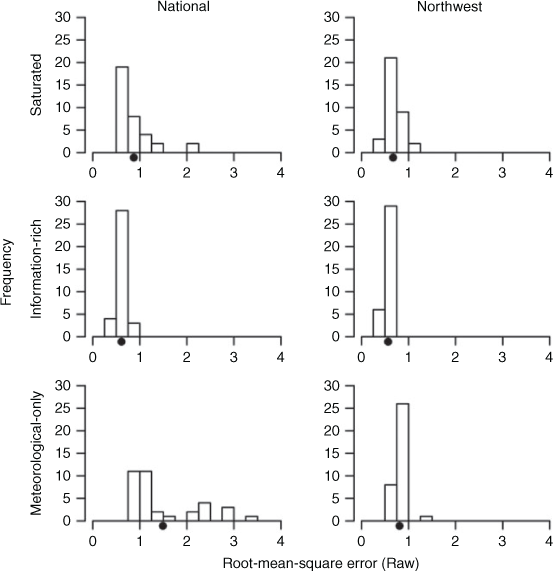
|
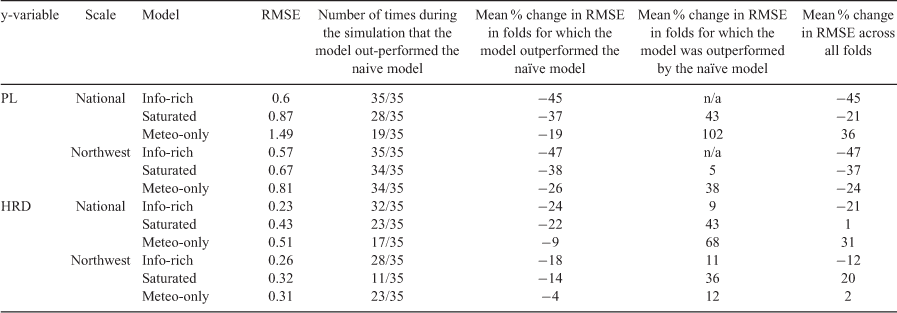
|
The relative ability of the models to predict PL using data beyond the training set – as compared with a naïve model – varies by geographic scale and data scenario. We define a naïve model to be one that is based only on the long-term average, i.e. intercept. We report simulation results in terms of the overall expected percentage difference in RMSE when using a particular model instead of a naïve model and the frequency with which a particular model outperforms a naïve model. Additionally, we report the conditional expected percentage difference in RMSE, which communicates the expected percentage difference between RMSEs if we know that a particular model outperforms or is outperformed by the naïve model (Fig. 4, Table 7).
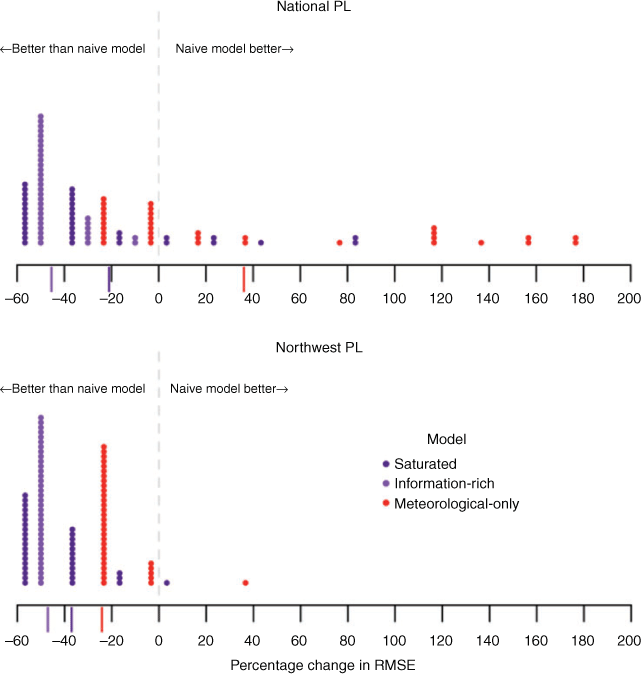
|
By these measures, the information-rich model most highly outperforms the naïve model at the national scale. The saturated model, to a lesser degree, also outperforms the naïve model. The meteo-only model fails to outperform the naïve model on average, although the conditional expected percentage difference in RMSE is much different in the folds preferring the naïve model compared with the folds preferring the meteo-only model. At the Northwest scale, the information-rich model again most outperforms the naïve model on average. The other linear models (the saturated and meteo-only) also both outperform the naïve model on average.
High-resource-demand models
The relative and absolute ability of the models to predict future HRD days is assessed using cross-validation with RMSE as a measure of performance. These additional results are reported in the Supplementary material. In short, the cross-validation of the ability of the models to predict HRD shows similar results to those described in the previous section when using the models to predict PL. The information-rich model again outperforms the naïve model and reports the lowest RMSE, on average, of the three models for both geographic scales. However, the models predict PL accurately more often than they are able to predict HRD for both geographic scales.
Discussion
Overall, the models explored exhibit medium to high explanatory power for predicting PL and high-resource-demand days for the national scale, and lower, but still strong, explanatory power for the Northwest scale. This suggests that the approach of forecasting PL to predict future wildfire risk and firefighting resource demand is feasible and has potential value for decision-making.
Important descriptive factors
By virtue of the model selection procedures, the only covariates that appear in all models are meteorological. At the national scale, temperature is a highly significant predictor of raw PLs and HRD in all three data availability model scenarios. Moreover, the effect of temperature on PL and HRD is always positive so that increases in temperature are associated with increases in resource demand. Temperature being a consistent predictor of resource demand at the national scale is consistent with other research identifying temperature as a critical mediator of wildfire activity, which alters flammability through a variety of pathways (Flannigan et al. 2009). Although no other meteorological predictor is as consistently effective as temperature at the national scale, at smaller spatial scales, the importance of temperature in models predicting PL and HRD diminishes. Specifically, at the Northwest scale, temperature is absent in the information-rich models and not significant in the saturated HRD model. Instead, FM1000 is always included by the statistical selection procedure and nearly always significantly associated with PL and HRD across the three data availability scenarios. In summary, the meteorological covariate that is most associated with resource demand varies by geographic scale, with temperature being preferred at the national scale and FM1000 being preferred at the Northwest scale.
Firefighting covariates are not considered in every data-availability scenario, but their apparent importance in the prediction of resource demand motivates a similar investigation to that which is applied to the meteorological covariates. Although some firefighting covariates may be important under particular proxies, geographic scales or data availability scenarios, the most consistent and strongly associated covariates are Total burned area, number of Type 1 fires and number of Type 2 fires. Specifically, across the relevant data availability scenarios (saturated and information-rich) and all geographic scales (national and Northwest), these three covariates are consistently significantly associated with both PL and HRD. The effect of Total burned area on resource demand is as expected – there is more demand for firefighters when there are large areas of actively burning landscape. Similarly, the number of Type 1 fires and Type 2 fires is positively associated with PL and HRD. With only one exception, the magnitude of the effect of Type 1 fires is greater than of Type 2 fires, which is consistent with the relative firefighting complexity of those designations. In summary, the effect of firefighting covariates on resource demand varies by geographic scale, choice of proxy and data availability. However, three firefighting covariates – Total burned area, Type 1 fires and Type 2 fires – are consistently and significantly associated with resource demand.
The results taken together suggest a simple robust model of resource demand that varies slightly at the national and Northwest geographic scales. On the national scale, a robust model of resource demand is one that includes Temperature, Total burned area, Type 1 fires and Type 2 fires. The slopes of these covariates across the models yield the following robust conceptual model of resource demand: ‘the demand for national firefighting resources increases as the number of wildfires, size of wildfires and temperature increases.’ At the Northwest scale, the meteorological covariates are substituted so that the robust conceptual model of resource demand becomes: ‘the demand for Northwest firefighting resources increases as the number of wildfires and the size of wildfires increase, and as fuel moisture decreases’.
Effects of data availability on performance
The availability of relevant information may vary depending on time scale. In the short term, information availability about firefighting and meteorological covariates is fairly high. Resource demand predictions can be informed by weather forecasts and provide reasonable estimates of firefighting covariates from administrative records. However, deep into the future, this same information is either unavailable or highly uncertain. Climate models can be used to project future weather conditions but cannot be used in the same way as weather forecasts. Climate model output is intended to inform long-term trends over many years, whereas weather forecasts can provide accurate predictions at little more than a week out (Rose and Floehr 2017). Prediction of PL in the Northwest is one context in which applying climate model projections to these resource demand models appears feasible. That said, firefighting covariates are conditional on several highly uncertain sociological, political and anthropological factors.
To that end, the meteo-only model explores the feasibility of predictions of resource demand when firefighting covariates are unavailable. The results of this study suggest that, in many cases, if firefighting information is unavailable, then usable predictions of resource demand cannot be made. When we are constrained to only use meteorological covariates, the only context in which our predictions outperform a naïve model is for PL in the Northwest. In every other case, the naïve model, i.e. constant prediction of PL or HRD, outperforms the meteorological model. This suggests that firefighting covariates are necessary for generating useful predictions of resource demand.
The results of the present study also suggest that good predictive performance can be obtained using a limited set of predictors. In every case examined, the information-rich models had the lowest RMSE, despite having fewer predictors than the saturated model. This suggests (1) that the information-rich models should be preferred in general, and (2) that many of the predictors of the saturated model do not add predictive power. In addition to superior predictive ability, the information-rich models and the meteo-only models avoided the multicollinearity problems observed in the saturated models (Supplementary material Fig. S3), which means that their coefficient estimates are more reliable.
Based on the adjusted R2 values, the saturated models are the overwhelming favourites. However, the cross-validation results suggest that predictions from the information-rich models are actually superior, consistently outperforming the saturated model in predicting data outside the training set (Fig. 2). Similar patterns in adjusted R2 are observed with the logit models. This suggests that if the goal is prediction, then adjusted R2 is an inadequate measure of performance.
Implications of climate change on firefighting resource demand
Given the overall importance of temperature to resource demand at the national scale, we can make projections about the future impact of climate change. Temperature averages in the United States are expected to increase over time (Maloney et al. 2014). Therefore, we expect that firefighting resource demand will intensify with a changing climate. Wildfire activity (number and burn area) is generally predicted to increase; therefore, resource demand is also likely to increase (Barbero et al. 2015; Podschwit et al. 2018). At the Northwest scale, fuel moisture is significantly associated with resource demand. Thus, increasing temperature and resultant lower fuel moisture are expected to increase resource demand over time (Gergel et al. 2017).
Limitations and caveats
Although the results of this study show that fire characteristics, and in some cases firefighting resource allocation and information, are particularly important covariates for describing PL trends, several uncertainties should be noted.
Doubtless, the models developed to predict resource demand could be improved by refining the model structure. Other generalised linear model structures could be examined to predict PL and HRD. A probit link function could be a reasonable substitute for the logit function, or a multinomial regression used to model PL (Faraway 2016). Entirely distinct modelling techniques to those described in the present manuscript could be adopted, such as decision trees (Podschwit et al. 2018) or generalised additive models (Faraway 2016). At least some of the simple regression models displayed potential trends in the residual plots (Supplementary material Figs S6, S7, S9, S14 and S15), which suggests that the simple models we developed might be improved by permitting the non-linear terms as a subsequent step.
It is also worth mentioning that other proxies of resource demand exist beyond those examined in this manuscript. For instance, number of firefighters per area of burning land could be used instead of PL to represent resource demand. If this substitution were made, the factors most robustly associated with resource demand – Temperature, FM1000, Total burned area, Type 1 fires and Type 2 fires – could be of lesser importance. Still, the results of this study illustrate that these variables are potentially important covariates to resource demand that should be subject to further investigation.
One potential consideration in applying these models to create future projections of PL is that they are based on historical drivers and contexts of resource demand, whereas future conditions may not resemble historical ones. Future wildfire behaviour may deviate from predictions for a variety of reasons including vegetation changes (Syphard et al. 2018), human pressures (Syphard et al. 2017) and firefighting policy (North et al. 2015). For example, in many western regions of the USA, increased application of fuel treatment and prescribed burning could offset future resource demand significantly (North et al. 2015).
Conclusions
In this study, we present models that predict two relevant proxies of resource demand – PL and HRD – under three data availability scenarios. Using a simple model selection procedure, we identify models that are capable of producing useful predictions of future resource demand conditions. These models are assessed further to determine (1) which predictors are associated with resource demand; and (2) how accurately each model can predict these proxies.
We find that, at the national scale, temperature is an important predictor of resource demand, whereas 1000-h fuel moisture is important at the Northwest geographic scale. We also find that Total burned area, number of Type 1 fires and number of Type 2 fires are broadly important to firefighting resource demand at both the national and Northwest geographic scale. We further assess the predictive performance of these models and find that in many contexts, the models produce adequately accurate predictions of resource demand proxies. However, predictive ability is always highest under a scenario where both firefighting and meteorological information are used for resource demand prediction. In some cases, firefighting information may be unavailable. We find that in many contexts, this scenario would result in models that predict resource demand no better than chance (i.e. naïve models). Hence, firefighting covariates are a required component of useful predictive models of resource demand.
The models presented in this paper have the potential to improve predictions of firefighting resource demand to aid firefighting decision-making and can serve as a guide for further investigation. Additionally, expected changes in temperature, fuel moisture and wildfire activity under climate change, paired with other important predictors identified in this analysis, suggest that resource demand will likely increase in the future.
Conflicts of interest
The authors declare no conflicts of interest.
Acknowledgements
The authors gratefully acknowledge Ed Delgado, Linda Mearns, Alex Masarie, John Abatzoglou and Natasha Stavros whose comments and suggestions focused and improved this research. The authors also wish to acknowledge the Weather and Climate Impacts Assessment Science Program (WCIASP) and the Regional Climate Uncertainty Program (RCUP), funded by the National Center for Atmospheric Research, and NSF’s Growing Convergence Research Program (Award Number 2019762), for generous support of this work.
References
Abatzoglou J (2013) Development of gridded surface meteorological data for ecological applications and modelling. International Journal of Climatology 33, 121–131.| Development of gridded surface meteorological data for ecological applications and modelling.Crossref | GoogleScholarGoogle Scholar |
Barbero R, Abatzoglou J, Larkin N, Kolden C, Stocks B (2015) Climate change presents increased potential for very large fires in the contiguous United States. International Journal of Wildland Fire 24, 892–899.
| Climate change presents increased potential for very large fires in the contiguous United States.Crossref | GoogleScholarGoogle Scholar |
Bednar L, Mees R, Strauss D (1990) Fire suppression effectiveness for simultaneous fires: an examination of fire histories. Western Journal of Applied Forestry 5, 16–19.
| Fire suppression effectiveness for simultaneous fires: an examination of fire histories.Crossref | GoogleScholarGoogle Scholar |
Diamantidis NA, Karlis D, Giakoumakis EA (2000) Unsupervised stratification of cross-validation for accuracy estimation. Artificial Intelligence 116, 1–16.
| Unsupervised stratification of cross-validation for accuracy estimation.Crossref | GoogleScholarGoogle Scholar |
Faraway JJ (2016) ‘Extending the linear model with R: generalized linear, mixed effects and non-parametric regression models.’ (CRC Press: Boca Raton, FL, USA)
Fischer P, Cullen AC, Ettl G (2017) The effects of forest management on carbon storage and revenue in western Washington: a probabilistic simulation of tradeoffs. Risk Analysis 37, 173–192.
| The effects of forest management on carbon storage and revenue in western Washington: a probabilistic simulation of tradeoffs.Crossref | GoogleScholarGoogle Scholar | 27164046PubMed |
Flannigan MD, Krawchuk MA, de Groot WJ, Wotton BM, Gowman LM (2009) Implications of changing climate for global wildland fire. International Journal of Wildland Fire 18, 483–507.
| Implications of changing climate for global wildland fire.Crossref | GoogleScholarGoogle Scholar |
Gebert KM, Calkin DE, Yoder J (2007) Estimating suppression expenditures for individual large wildland fires. Western Journal of Applied Forestry 22, 188–196.
| Estimating suppression expenditures for individual large wildland fires.Crossref | GoogleScholarGoogle Scholar |
Gergel DR, Nijssen B, Abatzoglou JT, Lettenmaier DP, Stumbaugh MR (2017) Effects of climate change on snowpack and fire potential in the western USA. Climatic Change 141, 287–299.
| Effects of climate change on snowpack and fire potential in the western USA.Crossref | GoogleScholarGoogle Scholar |
Krueger ES, Ochsner TE, Engle DM, Carlson JD, Twidwell D, Fuhlendorf SD (2015) Soil moisture affects growing-season wildfire size in the Southern Great Plains. Soil Science Society of America Journal 79, 1567–1576.
| Soil moisture affects growing-season wildfire size in the Southern Great Plains.Crossref | GoogleScholarGoogle Scholar |
Littell JS, McKenzie D, Kerns BK, Cushman S, Shaw CG (2011) Managing uncertainty in climate‐driven ecological models to inform adaptation to climate change. Ecosphere 2, 1–19.
| Managing uncertainty in climate‐driven ecological models to inform adaptation to climate change.Crossref | GoogleScholarGoogle Scholar |
Littell JS, Peterson DL, Riley KL, Liu Y, Luce CH (2016) A review of the relationships between drought and forest fire in the United States. Global Change Biology 22, 2353–2369.
| A review of the relationships between drought and forest fire in the United States.Crossref | GoogleScholarGoogle Scholar | 27090489PubMed |
Maloney ED, Camargo SJ, Chang E, Colle B, Fu R, Geil KL, Hu Q, Jiang X, Johnson N, Karnauskas KB, Kinter J, Kirtman B, Kumar S, Langenbrunner B, Lombardo K, Long LN, Mariotti A, Meyerson JE, Mo KC, Neelin JD, Pan Z, Seager R, Serra Y, Seth A, Sheffield J, Stroeve J, Thibeault J, Xie S, Wang C, Wyman B, Zhao M (2014) North American climate in CMIP5 experiments: Part III: assessment of twenty-first century projections. Journal of Climate 27, 2230–2270.
| North American climate in CMIP5 experiments: Part III: assessment of twenty-first century projections.Crossref | GoogleScholarGoogle Scholar |
Meyn A, White PS, Buhk C, Jentsch A (2007) Environmental drivers of large, infrequent wildfires: the emerging conceptual model. Progress in Physical Geography 31, 287–312.
| Environmental drivers of large, infrequent wildfires: the emerging conceptual model.Crossref | GoogleScholarGoogle Scholar |
North MP, Stephens SL, Collins BM, Agee JK, Aplet G, Franklin JF, Fule PZ (2015) Reform forest fire management. Science 349, 1280–1281.
| Reform forest fire management.Crossref | GoogleScholarGoogle Scholar | 26383934PubMed |
Podschwit H, Cullen A (2020) Patterns and trends in simultaneous wildfire activity in the continental United States from 1984–2015. International Journal of Wildland Fire
| Patterns and trends in simultaneous wildfire activity in the continental United States from 1984–2015.Crossref | GoogleScholarGoogle Scholar |
Podschwit H, Larkin N, Steel E, Cullen A, Alvarado E (2018) Multi-model forecasts of very-large fire occurrences during the end of the 21st century. Climate 6, 100
| Multi-model forecasts of very-large fire occurrences during the end of the 21st century.Crossref | GoogleScholarGoogle Scholar |
Rose B, Floehr E (2017) Analysis of high-temperature forecast accuracy of consumer weather forecasts from 2005–2016. Forecast Watch Report. (Dublin, OH, USA)
Schlobohm P, Brain J (2002) Gaining an understanding of the National Fire Danger Rating System. National Wildfire Coordinating Group Report NFES 2665. (Boise, ID, USA)
Svoboda M, Fuchs B (2016) Handbook of drought indicators and indices. In ‘Drought and water crises: integrating science, management, and policy, 2nd edn’. (Eds D Wilhite, RS Pulwarty) pp. 155–208. (CRC Press: Boca Raton, FL, USA)
Syphard AD, Keeley JE, Pfaff AH, Ferschweiler K (2017) Human presence diminishes the importance of climate in driving fire activity across the United States. Proceedings of the National Academy of Sciences of the United States of America 114, 13750–13755.
| Human presence diminishes the importance of climate in driving fire activity across the United States.Crossref | GoogleScholarGoogle Scholar | 29229850PubMed |
Syphard AD, Sheehan T, Rustigian-Romsos H, Ferschweiler K (2018) Mapping future fire probability under climate change: does vegetation matter? PLoS One 13, e0201680
| Mapping future fire probability under climate change: does vegetation matter?Crossref | GoogleScholarGoogle Scholar | 30192760PubMed |
Tedim F, Leone V, Amraoui M, Bouillon C, Coughlan M, Delogu G, Fernandes P, Ferreira C, McCaffrey S, McGee T, Parente J, Paton D, Pereira M, Ribeiro L, Viegas D, Xanthopoulos G (2018) Defining extreme wildfire events: difficulties, challenges, and impacts. Fire 1, 9
| Defining extreme wildfire events: difficulties, challenges, and impacts.Crossref | GoogleScholarGoogle Scholar |
Zhang D (2016) A coefficient of determination for generalized linear models. The American Statistician 71, 310–316.
| A coefficient of determination for generalized linear models.Crossref | GoogleScholarGoogle Scholar |


